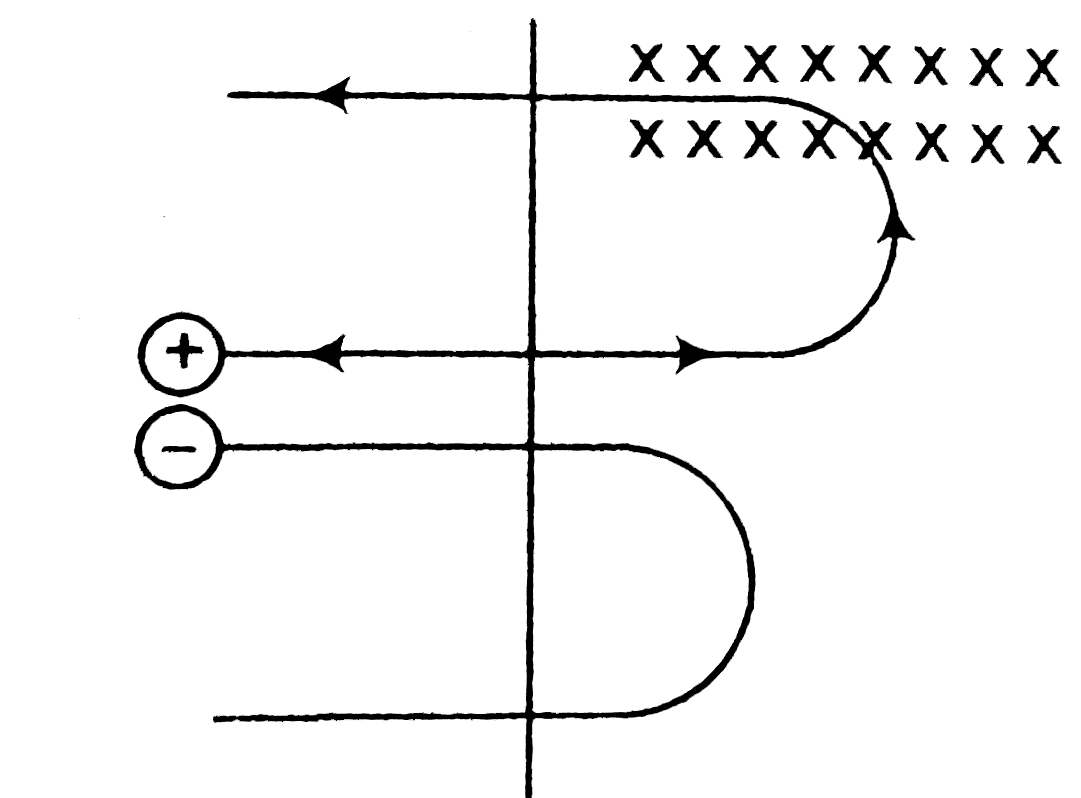An electron and a proton are moving on straight parallel paths with same velocity. They enter a semi infinite region of uniform magnetic field perpendicular to the velocity.
Which of the following statement(s) is /are true?
they will never come out of the magnetic field region
they will come out travelling along parallel paths
they will come out at the same time
none of the above
The correct Answer is:B
Radius r=mvBqor r∝m

∴ we have re<rp as me<mp
further time period T=2πmBq or T∝m→Te<Tp
te=Te2 and tp=Tp2
lte<tp
Topper's Solved these Questions
- MAGNETIC EFFECT OF ELECTRIC CURRENTBOOK - MHTCET PREVIOUS YEAR PAPERS AND PRACTICE PAPERSCHAPTER - MAGNETIC EFFECT OF ELECTRIC CURRENTEXERCISE - MHT CET CORNER
20 Videos
- MAGNETIC EFFECT OF ELECTRIC CURRENTBOOK - MHTCET PREVIOUS YEAR PAPERS AND PRACTICE PAPERSCHAPTER - MAGNETIC EFFECT OF ELECTRIC CURRENTEXERCISE - Exercise 1
36 Videos
- KINETIC THEORY OF GASES ANDRADIATIONBOOK - MHTCET PREVIOUS YEAR PAPERS AND PRACTICE PAPERSCHAPTER - KINETIC THEORY OF GASES ANDRADIATIONEXERCISE - MHT CET Corner
40 Videos
- MAGNETIC EFFECT OF ELECTRIC CURRENT -IBOOK - MHTCET PREVIOUS YEAR PAPERS AND PRACTICE PAPERSCHAPTER - MAGNETIC EFFECT OF ELECTRIC CURRENT -IEXERCISE - EXERCISE 2 (MISCELLANEOUS PROBLEMS)
20 Videos
Similar Questions
An electron and a proton are moving with the same kinetic energy along the same direction, When they pass through a uniform magnetic field perpendicular to the direction of their motion, they describe circular path of the same radius. Is this statement true or false?
View SolutionAn electron and a proton are moving with the same kinetic energy along the same direction . When they pass through a uniform magnetic field perpendicular to the direction of their motion , they describe circular paths of the same radius.
View Solution
Knowledge Check
A beam of electrons moving with a momentum p enters a uniform magnetic field of flux density B perpendicular to its motion. Which of the following statement(s) is (are) true?
AEnergy gained by electrons in megnetic field is p2/2mBCentripetal force on the electron is Bem/p.CRadius of the electron's path is p/BeDWork done on the electrons by the magnetic field is zeroAn electron and proton enter a uniform magnetic field perpendicularly. Both have same kinetic energy. Which of the following is true?
ATrajectory of electron is less curvedBTrajectory of proton is less curvedCBoth trajectories are equally curvedDBoth move on straight line pathAn electron and a proton enter a magnetic field perpendicularly. Both have same kinetic energy. Which of the following is true
ATrajectory of electron is less curvedBTrajectory of proton is less curvedCBoth trajectories are equally curvedDBoth move on straight-line path
An electron and a proton moving parallel to each other in the same direction with equal momentra, enter into a uniform magnetic field which is at right angles to their velocities. Trace their trajectories in the magnetic field.
View SolutionA proton and an electron both moving with the same velocity v enter into a region of magnetic field directed perpendicular to the velocity of the particles. They will now move in cirular orbits such that
View SolutionThere is a beam of electrons and protons in which both the particles are moving with the same velocity, entering a thin region, where a uniform magnetic field is applied perpendicular to the motion of beam. The protons and the electrons
View SolutionA proton and an electron are projected into a region of uniform magnetic field in a direction perpendicular to the field. If they have the same initial velocities then
View SolutionPath of an electron entering perpendicular in a uniform magnetic field will be:
View Solution
